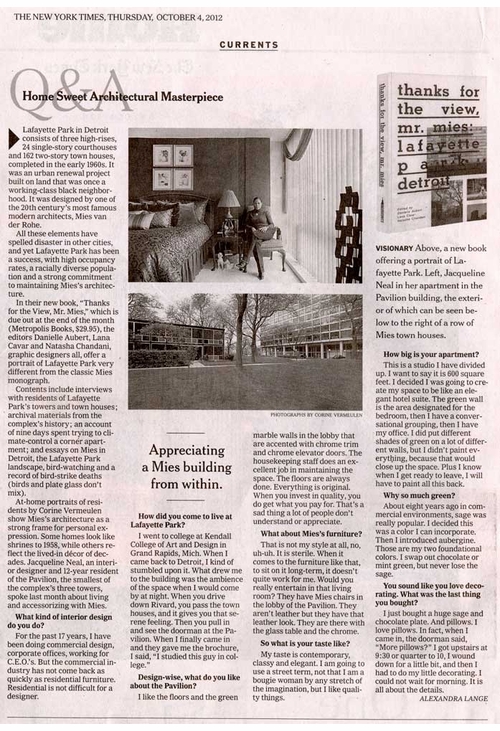| RECENT POSTS DATE 11/1/2024 DATE 10/27/2024 DATE 10/26/2024 DATE 10/24/2024 DATE 10/21/2024 DATE 10/20/2024 DATE 10/17/2024 DATE 10/16/2024 DATE 10/15/2024 DATE 10/14/2024 DATE 10/10/2024 DATE 10/8/2024 DATE 10/6/2024
| | | CORY REYNOLDS | DATE 10/4/2012In today's New York Times (Home Section), Alexandra Lange interviews Lafayette Park resident Jacqueline Neal on her experience living in Mies van der Rohe's Detroit architectural masterpiece, as detailed in the new METROPOLIS book.

Lafayette Park in Detroit consists of three high-rises, 24 single-story courthouses and 162 two-story town houses, completed in the early 1960s. It was an urban renewal project built on land that was once a working-class black neighborhood. It was designed by one of the 20th century’s most famous modern architects, Mies van der Rohe.
All these elements have spelled disaster in other cities, and yet Lafayette Park has been a success, with high occupancy rates, a racially diverse population and a strong commitment to maintaining Mies’s architecture.
In their new book, Thanks for the View, Mr. Mies: Lafayette Park, Detroit, which is due out at the end of the month (Metropolis Books, $29.95), the editors Danielle Aubert, Lana Cavar and Natasha Chandani, graphic designers all, offer a portrait of Lafayette Park very different from the classic Mies monograph.
Contents include interviews with residents of Lafayette Park’s towers and town houses; archival materials from the complex’s history; an account of nine days spent trying to climate-control a corner apartment; and essays on Mies in Detroit, the Lafayette Park landscape, bird-watching and a record of bird-strike deaths (birds and plate glass don’t mix).
At-home portraits of residents by Corine Vermeulen show Mies’s architecture as a strong frame for personal expression. Some homes look like shrines to 1958, while others reflect the lived-in décor of decades. Jacqueline Neal, an interior designer and 12-year resident of the Pavilion, the smallest of the complex’s three towers, spoke last month about living and accessorizing with Mies.
What kind of interior design do you do?
For the past 17 years, I have been doing commercial design, corporate offices, working for C.E.O.’s. But the commercial industry has not come back as quickly as residential furniture. Residential is not difficult for a designer.
How did you come to live at Lafayette Park?
I went to college at Kendall College of Art and Design in Grand Rapids, Mich. When I came back to Detroit, I kind of stumbled upon it. What drew me to the building was the ambience of the space when I would come by at night. When you drive down Rivard, you pass the town houses, and it gives you that serene feeling. Then you pull in and see the doorman at the Pavilion. When I finally came in and they gave me the brochure, I said, “I studied this guy in college.”
Design-wise, what do you like about the Pavilion?
I like the floors and the green marble walls in the lobby that are accented with chrome trim and chrome elevator doors. The housekeeping staff does an excellent job in maintaining the space. The floors are always done. Everything is original. When you invest in quality, you do get what you pay for. That’s a sad thing a lot of people don’t understand or appreciate.
What about Mies’s furniture?
That is not my style at all, no, uh-uh. It is sterile. When it comes to the furniture like that, to sit on it long-term, it doesn’t quite work for me. Would you really entertain in that living room? They have Mies chairs in the lobby of the Pavilion. They aren’t leather but they have that leather look. They are there with the glass table and the chrome.
So what is your taste like?
My taste is contemporary, classy and elegant. I am going to use a street term, not that I am a bougie woman by any stretch of the imagination, but I like quality things.
How big is your apartment?
This is a studio I have divided up. I want to say it is 600 square feet. I decided I was going to create my space to be like an elegant hotel suite. The green wall is the area designated for the bedroom, then I have a conversational grouping, then I have my office. I did put different shades of green on a lot of different walls, but I didn’t paint everything, because that would close up the space. Plus I know when I get ready to leave, I will have to paint all this back.
Why so much green?
About eight years ago in commercial environments, sage was really popular. I decided this was a color I can incorporate. Then I introduced aubergine. Those are my two foundational colors. I swap out chocolate or mint green, but never lose the sage.
You sound like you love decorating. What was the last thing you bought?
I just bought a huge sage and chocolate plate. And pillows. I love pillows. In fact, when I came in, the doorman said, “More pillows?” I got upstairs at 9:30 or quarter to ten, I wound down for a little bit, and then I had to do my little decorating. I could not wait for morning. It is all about the details.
 Metropolis Books
Pbk, 6.5 x 9.5 in. / 288 pgs / illustrated throughout.
| |
|

